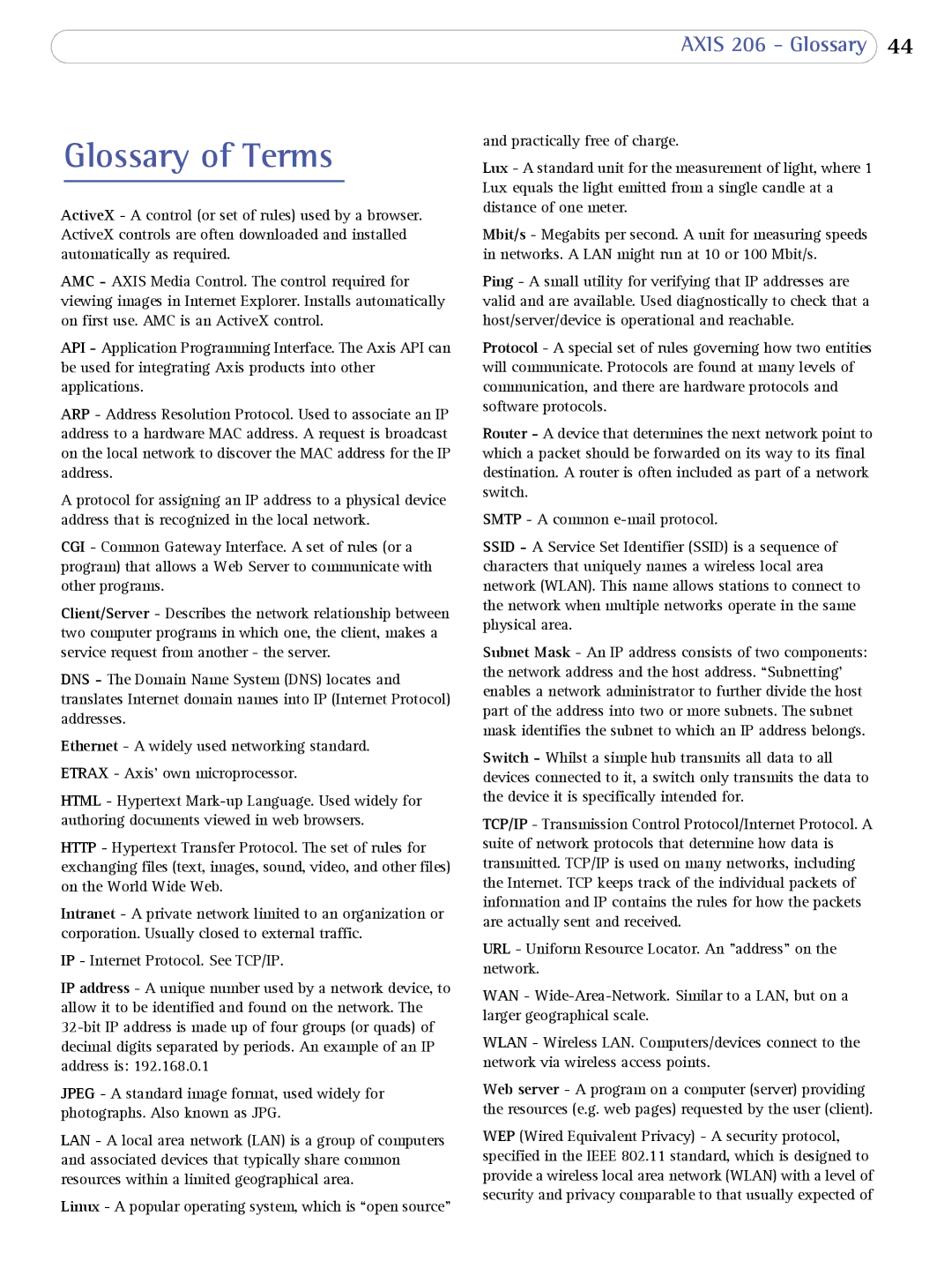
AXIS 206 - Glossary 44
Glossary of Terms
ActiveX - A control (or set of rules) used by a browser. ActiveX controls are often downloaded and installed automatically as required.
AMC - AXIS Media Control. The control required for viewing images in Internet Explorer. Installs automatically on first use. AMC is an ActiveX control.
API - Application Programming Interface. The Axis API can be used for integrating Axis products into other applications.
ARP - Address Resolution Protocol. Used to associate an IP address to a hardware MAC address. A request is broadcast on the local network to discover the MAC address for the IP address.
A protocol for assigning an IP address to a physical device address that is recognized in the local network.
CGI - Common Gateway Interface. A set of rules (or a program) that allows a Web Server to communicate with other programs.
Client/Server - Describes the network relationship between two computer programs in which one, the client, makes a service request from another - the server.
DNS - The Domain Name System (DNS) locates and translates Internet domain names into IP (Internet Protocol) addresses.
Ethernet - A widely used networking standard. ETRAX - Axis' own microprocessor.
HTML - Hypertext
HTTP - Hypertext Transfer Protocol. The set of rules for exchanging files (text, images, sound, video, and other files) on the World Wide Web.
Intranet - A private network limited to an organization or corporation. Usually closed to external traffic.
IP - Internet Protocol. See TCP/IP.
IP address - A unique number used by a network device, to allow it to be identified and found on the network. The
JPEG - A standard image format, used widely for photographs. Also known as JPG.
LAN - A local area network (LAN) is a group of computers and associated devices that typically share common resources within a limited geographical area.
Linux - A popular operating system, which is “open source”
and practically free of charge.
Lux - A standard unit for the measurement of light, where 1 Lux equals the light emitted from a single candle at a distance of one meter.
Mbit/s - Megabits per second. A unit for measuring speeds in networks. A LAN might run at 10 or 100 Mbit/s.
Ping - A small utility for verifying that IP addresses are valid and are available. Used diagnostically to check that a host/server/device is operational and reachable.
Protocol - A special set of rules governing how two entities will communicate. Protocols are found at many levels of communication, and there are hardware protocols and software protocols.
Router - A device that determines the next network point to which a packet should be forwarded on its way to its final destination. A router is often included as part of a network switch.
SMTP - A common
SSID - A Service Set Identifier (SSID) is a sequence of characters that uniquely names a wireless local area network (WLAN). This name allows stations to connect to the network when multiple networks operate in the same physical area.
Subnet Mask - An IP address consists of two components: the network address and the host address. “Subnetting’ enables a network administrator to further divide the host part of the address into two or more subnets. The subnet mask identifies the subnet to which an IP address belongs.
Switch - Whilst a simple hub transmits all data to all devices connected to it, a switch only transmits the data to the device it is specifically intended for.
TCP/IP - Transmission Control Protocol/Internet Protocol. A suite of network protocols that determine how data is transmitted. TCP/IP is used on many networks, including the Internet. TCP keeps track of the individual packets of information and IP contains the rules for how the packets are actually sent and received.
URL - Uniform Resource Locator. An "address" on the network.
WAN -
WLAN - Wireless LAN. Computers/devices connect to the network via wireless access points.
Web server - A program on a computer (server) providing the resources (e.g. web pages) requested by the user (client).
WEP (Wired Equivalent Privacy) - A security protocol, specified in the IEEE 802.11 standard, which is designed to provide a wireless local area network (WLAN) with a level of security and privacy comparable to that usually expected of
